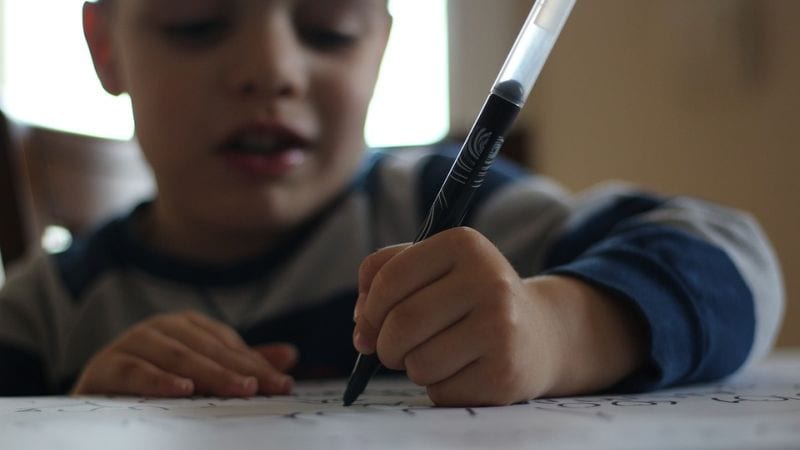When Joseph started learning to write, it became apparent he was left-handed. His dad, also a leftie, told him he was lucky: “When I was your age, they tied my left hand behind me and forced me to write with my right!” Teachers don’t force right-handedness on kids anymore, but left-handed students still face their own challenges in the classroom. Here are some tips to help them succeed.
Teaching Left-Handed Students to Write
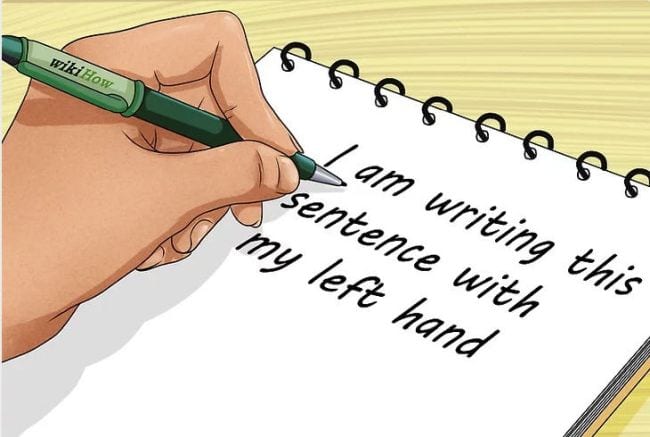
Source: wikiHow
Lefties have a reputation for sloppy handwriting, but given the right opportunities, they can learn to write as clearly as right-handers. It’s simply a matter of recognizing the challenges they face and offering solutions and accommodations.
If you’re right-handed, stop reading right now and try to write a couple of sentences left-handed. Really, try it! It’s the best way to understand some of these issues. Now you can see why left-handed students develop awkward grips and hand fatigue, tilt their paper to extreme angles, and hate three-ring binders. So how can teachers help?
Positioning the paper.
- Teach left-handed students to tilt the paper the opposite way to right-handed students.
- Position the paper an inch or two higher on the desk.
- Left-handers should use their right hand to brace the paper in place so it doesn’t slip.
Choosing and using the writing utensil.
- Allow some flexibility in writing utensils for lefties. Mechanical pencils are less likely to smear than regular ones. Crayons may be a better choice than markers in some cases. Still, smudges will happen, so quietly offer a wet wipe if you see a mess in the making.
- The way left-handed people grip a pen/pencil is responsible for much of their comfort and neatness. Ensure students hold it in the middle of the body—further away from the tip than right-handers—to keep their wrist off the page.
- Look into specialized grip tools and utensils that might make things easier, especially when they’re learning.
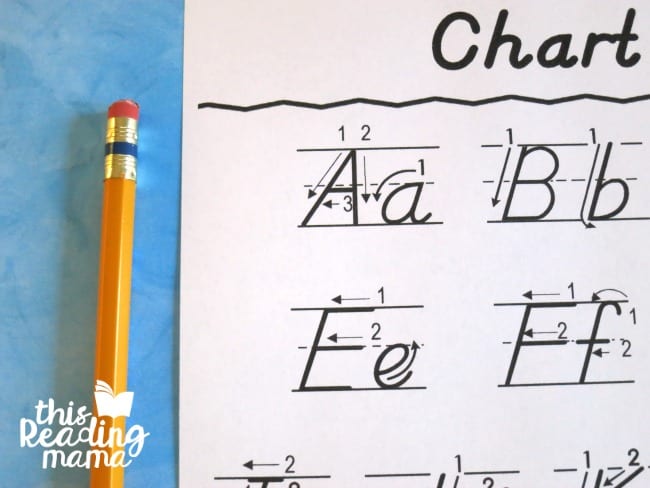
Source: This Reading Mama
Developing technique.
- Avoid “the hook,” bending the wrist around to write from above causes muscle cramp. Instead, encourage kids to keep their wrist below the line and their grip well away from the tip so they can see what they’re writing.
- Some left-handed students may be tempted to start writing on the right side of the page rather than the left. Put a dot at the beginning of the line to help them start in the correct place.
- Beginning writers may find it easier to make large letters, so they can more easily see what they’re doing. Their writing size will naturally reduce as they improve.
- Left-handers often make their cross marks (such as on the letter “t”) from right to left. They also write symbols like “O” in a clockwise instead of counter-clockwise direction. Don’t try to change this; this is more comfortable and much easier. There are handwriting charts available specifically for left-handers.
Consider other left-handed writing impacts.
- If you use three-ring binders, allow left-handed kids to take the paper out while they write on it, then put it back in when they’re done. Otherwise, they’ll wind up contorting their hand in awkward ways, like the picture below. Similarly, they may wish to flip spiral notebooks so the spiral is on the right.
- When designing worksheets, be sure letters or other figures to model appear either at the top, or on both sides of the page. If models appear only on the left, lefties will have to keep lifting their hand to see them as they work.
- If possible, try to find a left-handed adult with good writing technique who can spend some time teaching left-handed kids. You can also seek out example videos on the web.
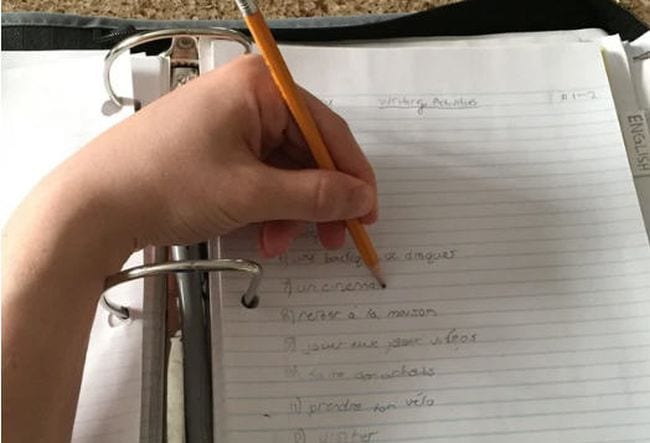
Source: Reddit
Other Left-Handed Considerations
Throughout their school years, and for the rest of their lives, left-handed students will find themselves needing to do some things a little bit differently. Help them by providing accommodations like these.
Don’t single them out.
It might be tempting on the first day of school to ask all left-handed kids to stand up or raise their hands. But most kids don’t want to feel singled out for this minor difference. Instead, observe students closely for a few days and make adjustments as needed.
Consider your seating arrangement.
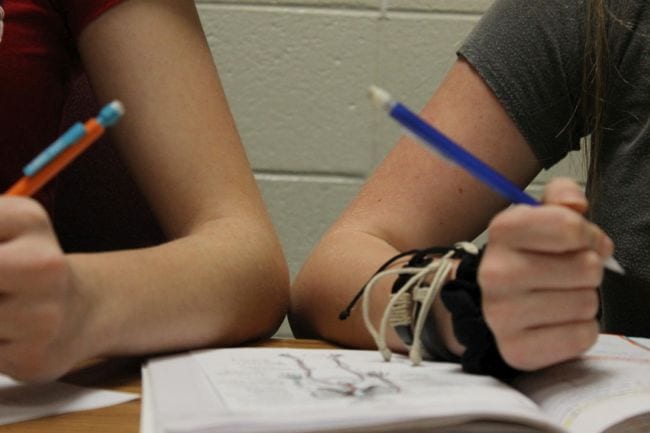
Source: Kiersten Long/RHS Register
If your room has tables instead of desks, remember that left-handed students might wind up bumping elbows constantly with right-handed kids next to them. Seat them on an end, or to the left of their desk mate. Upper-grade classrooms often have one-piece desks with an arm rest. Make sure each classroom has some left-handed desks available.
Provide helpful tools.
Every classroom should have at least a few pairs of left-handed scissors, marked so kids can find them. Note that true left-handed scissors not only have different grips, but also reversed blades, so left-handers can see what they’re cutting. We like this Kinderific Set of Six Kids’ Scissors with ergonomic grips. For older students, this Maped Expert pair gets great reviews.
Lefties may also appreciate specialized writing supplies. Firesara Left-Handed Pencil Grips come in several sizes for kids of any age. Pens specially designed for left-handers can reduce muscle fatigue and smearing; check out the Maped Viseo Pack of 2.
Adjust their computer mouse.
Most computers are automatically set up with the mouse on the right-hand side. Moving it around to the left is fairly simple, but you should also go into the computer settings and change the primary mouse button to the right one. If you don’t know how to do this, ask your school tech support. When kids are old enough, teach them how to do it themselves.
Teach skills by mirroring.
When it comes to things like tying shoes, sit across from the left-handed student instead of next to them. You’ll be mirroring the behavior, making it easier for them to follow along with the correct hand.

Source: LeftHand NZ
Be open to other alterations for left-handed students.
Left-handed students frequently adjust on their own to make tasks more comfortable. Allow them to make these changes whenever possible. In gym class, have a few left-handed baseball mitts. Music teachers can often restring instruments or make other changes for left-handed kids. In general, keep an eye out for lefties struggling to complete a task that’s easy for right-handers and then find out how you can help.
Encourage your class to embrace differences.
While lefties don’t want to be singled out, it’s important to help your class recognize that most people do have “handedness.” Read a book together, like Judy Moody: Not-So-Lucky Lefty. Do an activity where everyone tries using their “other hand.” Share with them a list of well-known left-handed people. Show them that being left-handed is an awesome characteristic.
How do you help left-handed students in your classroom? Share in the comments or come chat with other teachers in the WeAreTeachers HELPLINE Facebook group.
Do you have a student whose handwriting is abysmal, no matter what you try? Find out what teachers need to know about dysgraphia , a learning disorder that makes writing a huge challenge.
This post contains Amazon Affiliate links. WeAreTeachers may receive a very small percentage of the price when you purchase through these links.

